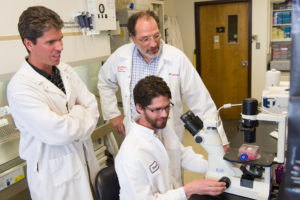
Graduate student Jessie Haugen Frenkel explains lab techniques to Fort Collins area high school students at Colorado State University’s Research and Innovation Center during World TB Day 2016. Photo: John Eisele/CSU Photography
Although tuberculosis was one of the top 10 causes of death worldwide in 2016 — topping HIV and malaria — most Americans remain unaware of the health threat. A group of young researchers at Colorado State University hopes to change that by putting eye-catching images of TB bacteria on leggings and other sportswear.
Alexandra Todd, research associate in the Department of Microbiology, Immunology & Pathology, said the inspiration for this project came to her after seeing an arrestingly beautiful image under the microscope in CSU’s Mycobacteria Research Laboratories.
“They were really cool images, and they look celestial,” she said. Todd thought the designs would mesh well with current fashion trends, while also showcasing science in a really different way.

She shared the idea to create something with the images with her lab mate Jessie Haugen Frenkel, a CSU alumna (’13) who is pursuing a doctorate in immunology. Frenkel, in turn, did some brainstorming with her husband, Daniel, a local businessman.
They formed a company, CureGear, and recently launched a campaign on Kickstarter to promote the science-inspired leggings, with an aim to increase awareness about science among women and girls, and to support research. A portion of the proceeds will be donated to research labs; the campaign ends Sept. 23.
The team was inspired by companies like Love Your Melon, the brainchild of two students at the University of St. Thomas in Minnesota. Launched in 2012, Love Your Melon sells beanies, caps, t-shirts, sweatshirts, and other accessories. The company has donated more than 110,000 hats to kids battling cancer and $2.6 million to pediatric cancer research.
Science creativity
CSU Professor Randy Basaraba, one of 20 researchers whose lab resides in the world-renowned Mycobacteria Research Laboratories, said he’s impressed by the hard-working young researchers. What they’re doing aligns with the lab’s goal to create an environment where people use creative skills, not only in solving important medical questions but also in promoting what they do.
“The thing I love about science is creativity, and this goes above and beyond what we envision as being creative in the laboratory,” Basaraba said. “I appreciate their recognition of the intrigue and visual appeal that the images they’ve put on their leggings have.”

CureGear worked with CSU Ventures, the university’s tech transfer division, to secure the rights to sell products with images from the lab. That means the CSU scientists who created the images will get royalties for the work.
The design on the initial line of leggings stem from images created by Assistant Professor Brendan Podell, whose work focuses on autoimmunity and infectious disease, with an emphasis on diabetes and tuberculosis.
With the crowdfunding goal nearly in sight, what’s next? “More leggings!” said Todd, laughing. The team hopes to soon create more designs using additional research images.
Frenkel said they’ve already accomplished one of their goals: to connect with women in science across the country. “It’s been a fun way to communicate what we do to others, too,” she said.
Basaraba applauded the visibility CureGear brings to the research lab. “Anything you can do to bring visibility to important human health challenges is worthy,” he said.
TB facts, stats
- Tuberculosis is one of the top 10 causes of death worldwide.
- In 2015, an estimated 1 million children became ill with TB and 170,000 children died of TB.
- More than 9,500 TB cases were reported in the United States in 2015.
- TB is a leading killer of people who are HIV-infected.
- 49 million lives were saved through TB diagnosis and treatment between 2000 and 2015.
Sources: World Health Organization, Centers for Disease Control and Prevention